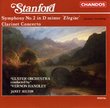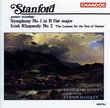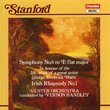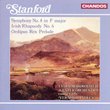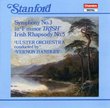| All Artists: Charles Villiers Stanford, Vernon Handley, Ulster Orchestra, Donald Davison Title: Stanford: Symphony 5 / Irish Rhapsody 4 Members Wishing: 0 Total Copies: 0 Label: Chandos Release Date: 10/28/1992 Genre: Classical Styles: Historical Periods, Romantic (c.1820-1910), Symphonies Number of Discs: 1 SwapaCD Credits: 1 UPC: 095115858127 |
Search - Charles Villiers Stanford, Vernon Handley, Ulster Orchestra :: Stanford: Symphony 5 / Irish Rhapsody 4
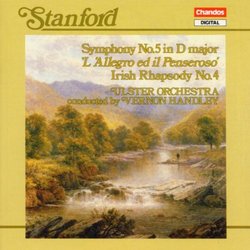 | Charles Villiers Stanford, Vernon Handley, Ulster Orchestra Stanford: Symphony 5 / Irish Rhapsody 4 Genre: Classical
|
Larger Image |
CD DetailsSimilar CDs |
CD ReviewsStanford's best symphony R. Broadhead | Southwestern USA | 06/09/2007 (5 out of 5 stars) "The Anglo-Irish composer Sir Charles Stanford wrote his Symphony No. 5 in 1894 and it was first performed in 1895. This symphony was not published until 1923, one year before the composer's death.
This is in many respects Sir Charles' finest symphony. It contains many original and attractive melodies that are well orchestrated and see significant thematic development. Many gentile horn calls are featured. Themes are never belabored but either are interweaved with other melodies or evolve into other melodies before they become belabored or tedious. The different themes are intertwined with each other and make dynamic use of the tonal and textural contrasts of woodwinds, brass and strings. An organ is effectively incorporated into the last movement. The music varies from soft and introspective to exuberant and rollicking, but is never harsh and never dissonant. This is a truly enjoyable symphony and one of the best of the late romantic period. The Fourth Irish Rhapsody is also an enjoyable work, based on fishing songs. This rhapsody was written in 1913. It starts out quiet and mysterious and ends up energetic and very outgoing. Stanford shows considerable skill and imagination in the thematic development of the folk melodies that constitute the basis of this music. It is a good companion piece for the Fifth Symphony. As with the other recordings of Stanford's symphonies by Vernon Handley and the Ulster Orchestra, the music is played well and clearly and is well paced. The acoustics of the recording are excellent with clear, well-balanced sound - all of the instruments are distinct and well reproduced. If you are interested in some of the best music the late romantic period has to offer, this recording is an excellent place to start." |

 Track Listings (5) - Disc #1
Track Listings (5) - Disc #1